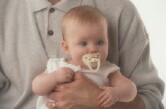
MONDAY, Feb. 20 (HealthDay News) — Experts are beginning to believe some that some non-headache health problems in childhood — such as vomiting and vertigo — might be linked to migraines later in life. Now, a new study suggests a connection between mothers with migraines and colic in infancy.
Colic is a condition marked by excessive crying in an otherwise healthy child.
“Mothers with a history of migraine were more than two-and-a-half times more likely to have a baby with colic than mothers who didn’t have migraine,” said study author Dr. Amy Gelfand, a pediatric neurologist with the Headache Center at the University of California, San Francisco.
The findings were released online Feb. 20 and Gelfand and colleagues will present them in April at the American Academy of Neurology’s annual meeting in New Orleans.
The researchers developed a questionnaire to help pinpoint whether a baby had colic and to identify mothers who had been diagnosed with a migraine, a condition believed to have a strong genetic link.
“We surveyed the mothers when they brought their babies into the pediatrician’s office for their two-month well-baby check-up,” Gelfand said.
Data from 154 mothers and their babies showed that nearly 29 percent of the babies whose mothers had a history of migraine had colic, compared with about 11 percent of babies whose moms did not report migraines.
“There was a trend when fathers answered the survey, too,” Gelfand added. She said 93 survey-takers answered paternal migraine history questions. The results: about 22 percent of colicky babies had a father with migraine compared to only nearly 10 percent of the babies who did not have the condition.
Chronic and often disabling, migraine headaches affect more than 29 million Americans, according to the U.S. Department of Health and Human Services’ Office on Women’s Health.
Three-quarters of migraine sufferers are women and previous research suggests about half of migraine sufferers remain undiagnosed.
“The bottom line is that migraine is an inherited disorder that involves the whole body,” said neurologist and pain medicine specialist Dr. Joel Saper, director of the Michigan Headache & Neurological Institute, in Ann Arbor.
Saper, who was not involved in the study, said people who are prone to migraine react to overstimulation throughout the course of their lives. He said the new research suggests “it’s very possible colic is an early manifestation of migraine.”
Saper explained that babies and children have immature nervous systems that don’t work the same way as an adult’s. He said migraine — a neurological condition — might manifest differently in babies and children.
“The underlying pathophysiology might be the same, but the reflexes are different,” Saper said.
The researchers said colic did not appear to be linked to the sex of a child. Also, while they did not ask whether babies were breast- or bottle-fed, other studies suggest colic rates do not differ for the two groups of infants, Gelfand noted. She said it’s still being debated whether cow’s milk protein might play a role in some children, though.
Currently, most parents are advised to wait out the weeks or months it takes for colic to resolve, to sooth and hold their baby, and to ask for help — a parent time-out — if the chronic crying frays nerves.
Commenting on the study, pediatrician Dr. Tai Lockspeiser, an assistant professor of pediatrics at the University of Colorado School of Medicine and Children’s Hospital Colorado, said, “All babies cry and colic is just one end of the spectrum.” She recommends “the 5 S’s System” made popular by Dr. Harvey Karp: swaddling, sucking, side-lying, shushing and swaying. “There are some great YouTube videos of this online that demonstrate exactly what these are,” Lockspeiser said.
For her part, Gelfand said that “it’s too early to change any kind of protocol for colic. But this gives pediatricians and neurologists another hypothesis to consider. Parents could try non-medication strategies that help some adult migraine sufferers, she said.
“Turning down loud music, going to a quiet room and decreasing stimulation might help,” Gelfand said. She also suggested moms and dads keep a “crying diary” to track when colic flare-ups tend to occur and anything that seems to calm the baby.
Saper said the new research offers another clue into the evolution of migraine in an individual. “We are now able to say this child may be on a pathway.”
The next research step will be to follow the babies over the years, said Gelfand.
“Right now we’re using the mothers’ migraines, but what we really want to know is do these babies themselves go on to have migraine,” she said.
The data and conclusions of this research should be viewed as preliminary until published in a peer-reviewed journal.
More information
Visit Nemours to learn about colic.

